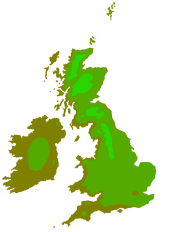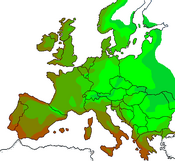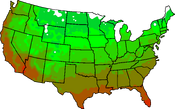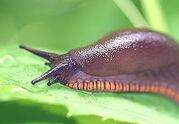| Swiss chard | |
|---|---|
 |
|
| Swiss chard "Bright lights" | |
| Scientific Classification | |
| Kingdom: | Plantae |
| (Unranked): | Angiosperms |
| (Unranked): | Eudicots |
| Order: | Caryophyllales |
| Family: | Chenopodiaceae |
| Genus: | Beta |
| Species: | Beta vulgaris var. cicla |
| Synonyms | |
| Chard
Perpetual spinach |
|
| Plant Data | |
|---|---|
| Min germination temp: | 10°C (50°F) |
| Max germination temp: | 30°C (86°F) |
| Germination time: | 8 days |
| Time to harvesting: | +60 days |
| Mature height: | 45cm (17.5in) |
| Mature spread: | 30 cm (12in) |
| Ideal pH range: | 6.1 - 7.5 |
| Sow depth: | 1cm (0.5in) |
| Sow spacing: | 10cm (4in) |
| Sow row spacing: | 40cm (15in) |
| Hardiness Zones | ||||||||||||||||||||||||||
|---|---|---|---|---|---|---|---|---|---|---|---|---|---|---|---|---|---|---|---|---|---|---|---|---|---|---|
| ||||||||||||||||||||||||||
| ||||||||||||||||||||||||||
| ||||||||||||||||||||||||||
| ||||||||||||||||||||||||||
Swiss chard (Beta vulgaris var. cicla) is a leafy vegetable, and is one of the cultivated descendants of the sea beet, Beta vulgaris subsp. maritima. Although the leaves are eaten, it is within the same species as beetroot, which is usually grown primarily for its edible roots.[1]
Planner[]
| JAN | FEB | MAR | APR | MAY | JUN | JUL | AUG | SEP | OCT | NOV | DEC | |||||||||||||
|---|---|---|---|---|---|---|---|---|---|---|---|---|---|---|---|---|---|---|---|---|---|---|---|---|
| Sowing Time | ||||||||||||||||||||||||
| Picking Time | ||||||||||||||||||||||||
Growing[]
Location[]
Choose a sunny spot to plant chard in although it will tolerate partial shade. It can withstand a very mild frost, but tender new leaves will be damaged, consider covering with a cloche if this is liable to be an issue. Being a cool weather crop, if it does get too sunny/dry it is liable to bolt.
Soil[]
Dig over the soil 2 weeks before sowing and incorporate some organic matter to increase water retention and aeration. Break up any large clods of soil to produce a fine, even tilth. Ideally a nutral pH is required.
Sowing[]
Sow directly into the soil from late March after the last frost. Prepare drills 1cm (0.5in) deep and 40cm (15in) apart. Sow seeds 10cm (4in) apart.
In this way you'll get an early harvest of younger, tender leaves suitable for salads.
Aftercare[]
You do not need to water chard as much as ordinary spinach, but will still require regular watering or it may bolt. If this occurs cut the flower head off to extend the harvest.
Harvest[]
Chard is considered a 'cut and come again' crop. This means you do not need to lift the whole plant, but rather take the leaves that you need (ideally the older ones) and it will continue to produce new growth. Older leaves will become more fibrous so harvesting regularly will ensure a continual supply of tender, younger leaves for the duration of the season. Be sure not to damage the central bud at the base of the stalks when harvesting.
Storage[]
Chard does not store for more than 3 days in the fridge, similar to beet greens. However, you can freeze it to add to soups, stews, curries etc if you blanch it first. Consider packing blanched spinach (or perinto ice cube trays and then storing the frozen cubes in bags to add one individually to meals.
Perpetual spinach[]
Perpetual spinach, a descendant of Swiss chard, is related to the former, but has purplish savoy leaves, adding the "bleeding" effect from Beetroot.
Troubles[]
References[]
- ↑ Eat with the beet, Monty Don, 9 February 2003, The Guardian





